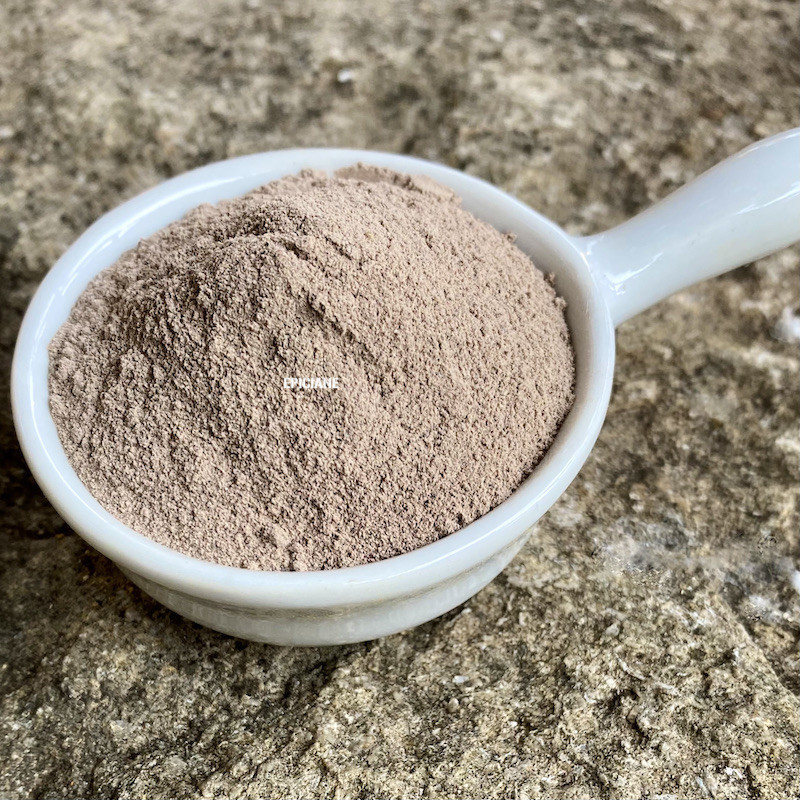
Reference: 6K4878201


A perfectly natural cleansing clay for beautiful, clean hair without any harsh effects.
This ghassoul is available as an extremely fine, unscented powder, free from any sand.
 Delivery
Delivery
Mondial Relay
 Returns
Returns
See conditions
 Payments
Payments
100% secure
Livré en sachet refermable
How to Use?
Ghassoul is primarily used for cosmetic purposes. It allows you to wash and care for your hair, exfoliate your body, and apply purifying masks to your face. This clay does not foam at all, with a fine, smooth texture, making it more like a soft mud that you spread on your hair or body.
Unlike soaps, ghassoul contains no surfactants. Instead, it acts like a blotter, providing targeted cleansing by absorbing and removing impurities.
The color of the powder ranges from beige to gray-brown. The clay is naturally harvested and sun-dried, without any chemical treatment or preservatives. The ghassoul is then purified of impurities and finely ground into an ultra-fine powder. You may also find it sold as "plaquettes," or unpurified chunks containing small stones.
To prepare, mix ghassoul powder with warm water to create a thick paste (use almost the same volume of water as ghassoul powder) and let the clay sit for a few minutes to fully absorb the water. You can prepare it in advance, as the paste keeps for many days in a sealed container. This saves time, especially on busy days, and ensures perfectly hydrated ghassoul, which is economical. If you have a favorite scent (essential oil, body fragrance), feel free to add a few drops to your ghassoul for a beautifully scented result.
For Hair:
It’s an excellent fortifying agent, especially recommended for oily hair, as it purifies and regulates sebum production. For "normal" hair, it adds a silky, shiny effect and makes detangling easier.
For the Face:
With weekly use, it brightens the complexion and is effective against blackheads and acne.
For the Body:
It softens the skin and gives it a satiny look that lasts for days.
The high mineral content in ghassoul captures and removes impurities. This mineral presence also gives the skin a uniquely soft, silky feel after washing. Impurities, dead cells, and oils are rinsed away with water, allowing for gentle and deep cleansing of the skin and hair without any irritation to skin, hair, or mucous membranes.
Its very low aluminum oxide and calcium oxide levels make it suitable for very sensitive areas, like the eye contour.
Its degreasing properties make it popular as a "mineral soap," particularly for acne.
Natural Ghassoul Shampoo:
Mix ghassoul powder with warm water until it forms a smooth paste. Apply it to your damp hair, massaging the scalp gently to distribute the product, then leave it for 15 minutes. If you're short on time, a few minutes while you wash your body will still yield excellent results. Rinse thoroughly. For a finishing touch, add a squeeze of lemon juice to the final rinse water.
Hair Mask with Ghassoul:
Mix 50 g of pre-prepared ghassoul paste (or more, depending on hair length and volume) with an egg yolk. Apply the paste to damp hair from roots to ends. Leave it on for 15 minutes, keeping the ghassoul moist, then rinse thoroughly. Let your hair air dry.
Who am I?
Origin: Morocco
Ghassoul (also spelled rassoul or rhassoul) is a natural volcanic clay primarily composed of silicon, magnesium, and lithium, along with iron, zinc, sodium, phosphorus, potassium, and silica. Its pH is neutral.
Ghassoul is processed through a "crop" method, involving natural drying, washing to remove impurities, and filtering. The purified ghassoul is sun-dried in large sheets before being ground into powder without additives.
When moistened, it forms a mud with cleansing and degreasing properties. Its water absorption capacity surpasses other clays, absorbing 1.66 times its weight in water.
Traditionally used for centuries in the Maghreb for skin and hair care, ghassoul is now a staple in spas and hydrotherapy centers. It is included in cosmetic, dermatological, and pharmaceutical products and serves as a primary ingredient in stomach dressings.
It even cleanses sheep wool and acts as a natural water purifier, used in ultrafiltration membranes to neutralize pesticide residues, including fungicides.
Ghassoul is a sedimentary rock from the Tertiary period, likely Jurassic, with a lacustrine origin.
A Little History:
The name "ghassoul" derives from an Arabic term meaning "that which washes."
Most ghassoul comes from Morocco, specifically the Tamdafel deposit in the Atlas Mountains, about 200 km south of Fez, covering thousands of hectares. The poor, clay-rich soil makes agriculture unreliable, rendering this a very impoverished region. Smaller deposits exist in Algeria but are minor by comparison. After extraction and drying, this clay is exported globally.
The Moroccan deposit’s exploitation began around the 12th or 13th century, though Egyptians and Romans referenced it even earlier.
Data sheet
Reference: 6K4878201
Reference: aubepinefl
Reference: 6L5609803
Reference: 6K4878201
Reference: 3N7201902
Reference: laurierE
Reference: gentiane
Reference: 408164502
Reference: 6N7456401
Reference: 11N7866301
Reference: 112930001
Reference: 9N7669901
Reference: PL-EK0-07
Reference: 20731803
Reference: 7K4954201
Reference: angelique
Reference: 121320001

A perfectly natural cleansing clay for beautiful, clean hair without any harsh effects.
This ghassoul is available as an extremely fine, unscented powder, free from any sand.